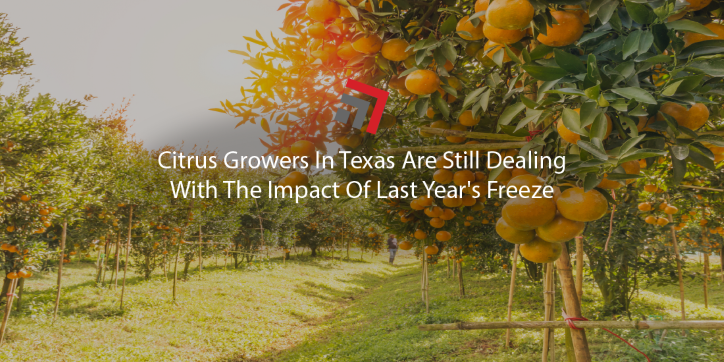Texas faces a winter storm this week, as citrus growers in Texas are still feeling the impact of last February’s winter freeze.
Before the winter freeze in Texas last year, which for 10 days straight dropped temperatures below freezing, Rio Grande Valley producers had 80% of their orange crop harvested, as well as 67% of their grapefruit crop harvested, Freightwaves reported. However, the remainder of their crops that still needed to be harvested were all lost, Juan Anciso, Ph.D., a horticulturist for Texas A&M AgriLife Extension Service told Agrilife Today.
Texas is the third-largest citrus-producing state behind California and Florida, and the Rio Grande Valley citrus industry brings in around $468 million in annual business, reported Freightwaves. However, it was reported that last year’s storm caused $230 million in significant damages to the Valley’s citrus crops, as well as $150 million in damages to vegetable crops.
Labor shortages, higher fertilizer prices and rising transportation costs have also contributed to a lower crop season for citrus growers.
Rising Transportation Costs
Agriculture depends a great deal on transportation when moving citrus commodities and other products from point A to point B, and other necessary supplies and equipment for their farms.
“We are seeing transportation costs that are 100% higher than normal,” Dante Galeazzi, president of the Texas International Produce Association stated. Fertilizer costs are up from 130% to 230% for farmers and growers as well.
Demand for refrigerated or reefer truckload capacity (as fresh produce usually gets hauled by reefer trucks) has been rising significantly through the first of the month this year. According to Freightwaves, on January 9th, truckload reefer spot rates hit a high of $4.88 (including fuel surcharges), compared to $3.82 in the same period in 2021.
When transportation costs rise, that impacts the cost of the product… in this case fruits and vegetables.
What the 2022 citrus season looks like
It takes more than a year to recover from those types of damages, something Dale Murden, a farmer and president of Texas Citrus Mutual, knows firsthand telling Freightwaves, it will take 2-3 years to get the citrus production back to where it needs to be. When the winter storm hit in February, “we had last year’s crop, but we were also blooming and going into our next crop for 2022, so this season we’re harvesting about 30% of a normal crop,” he continued.
Citrus production this season in the Rio Grande Valley is down almost 40% from the 2019-2020 season; orange production down 22% and grapefruit production down 45%, according to Freightwaves.
Some of the damage from 2021 has even stopped some citrus workers from working in the industry altogether. To learn more about this, or any questions/comments, please reach out to a team member today!



Recent Comments